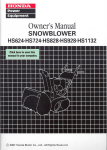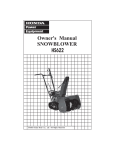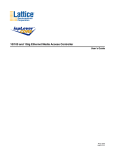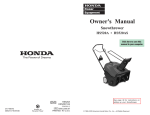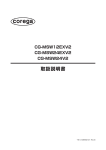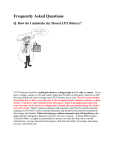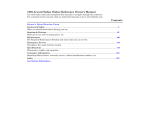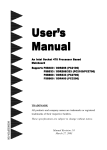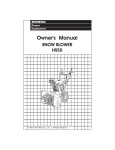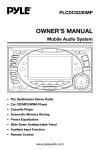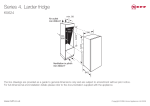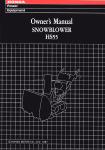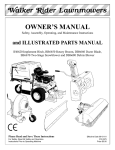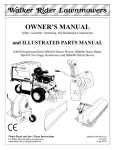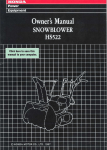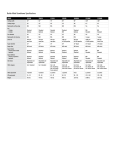Download Honda HS624 User's Manual
Transcript
Owner's Manual HS624 • HS828 ©1992 Honda Motor Co., Ltd.—All Rights Reserved Thank you for purchasing a Honda snowblower. We want to help you get the best results from your new snowblower and to operate it safely. This manual contains the information on how to do that; please read it carefully. This owner’s manual describes the operation and maintenance of Honda snowblower: HS624/HS828 All information in this publication is based on the latest product information available at the time of printing. Honda Motor Co., Ltd. reserves the right to make changes at any time without notice and without incurring any obligation. No part of this publication may be reproduced without written permission. This manual should be considered a permanent and should remain with it if it is resold. part of the snowblower Safety Messages Your safety and the safety of others is very important. We have provided important safety messages in this manual and on the snowblower. Please read these messages carefully. A safety message alerts you to potential hazards that could hurt you or others. Each safety message is preceded by a safety alert symbol and one of three words: DANGER, WARNING, or CAUTION. A These mean m You WILL be KILLED or SERIOUSLY HURT if you don’t follow instructions. B You CAN follow instructions. B be KILLED or SERIOUSLY HURT if you don’t You CAN be HURT if you don’t follow instructions. Each message tells you what the hazard is, what you can do to avoid or reduce injury. Damage Prevention Messages You will also see other important NOTICE. can happen, messages that are preceded and what by the word This word means: /TzEiq y our snbwblower or other property could be damaged if you don’t follow instructions. The purpose of these messages is to help prevent snowblower, other property, or the environment. damage to your 1 CONTENTS SAFETY ................................................................................................................ Safety Label Locations ................................................................................... Safety Information ......................................................................................... ...................................................................... IDENTIFICATION.. COMPONENT CONTROLS ......................................................................................................... Engine switch .................................................................................................. Fuel valve.. ....................................................................................................... Fuel gauge ....................................................................................................... Chute crank ................................................................................................... . ......................................................... Starter grip .......................................... Throttle lever(Engine speed) ....................................................................... Shift lever ...................................................................................................... Chute guide ................................................................................................... Drive clutch lever and auger clutch lever .................................................... Skid plate, scraper ....................................................................................... Foot pedal ....................................................................................................... Transmission release lever.. ........................................................................ CHECK.. .............................................................................. PRE-OPERATION ................................................................................... Fuel recommendation Engine oil ......................................................................................................... Hydrostatic transmission fluid ..................................................................... Auger and blower bolts.. .............................................................................. Other checks.. ............................................................................................... STARTING THE ENGINE .................................................................................. SNOW BLOWER OPERATION ......................................................................... Clearing snow ............................................................................................... STOPPING THE ENGINE .................................................................................. ................................................................................................ MAINTENANCE Maintenance schedule ................................................................................. Tool kit.. ......................................................................................................... Engine oil change ........................................................................................... Spark plug service ......................................................................................... Track-adjustment ......................................................................................... inspection.. ................................................................................ Wheel/Tire inspection.. ........................................................................... Auger/Blower TRANSPORTING .............................................................................................. Before loading ............................................................................................... Loading .......................................................................................................... STORAGE .......................................................................................................... TROUBLESHOOTING.. ..................................................................................... SPECIFICATIONS ............................................................................................. COSTOMER SERVICE INFORMATION .......................................................... INDEX ................................................................................................................. 2 3 3 .4 .7 .9 .9 .9 10 10 .l 1 .l 1 .12 .12 13 .14 15 .16 .17 17 19 20 .21 .21 .22 .27 .30 .32 .34 .35 .36 37 38 .39 .40 .41 .42 .42 .42 44 .47 .48 .50 51 SAFETY Safety label locations These labels warn you of potential Read them carefully. hazards that can cause serious If a label comes off or becomes hard to Snowblower dealer for a replacement. read, contact your injury. Honda 3 Safety information To ensure safe operation l Always make a pre-operation check (pages 17 thru 21 1 before you start the engine. You may prevent an accident or equipment damage. l Honda snowblowers are designed to give safe and dependable service if operated according to instructions. Read and understand this Owner’s Manual before operating the snowblower. Failure to do so could result in personal injury or equipment damage. l Before operating the snowblower, inspect the area in which you are going to clear snow. Remove debris and other obstacles the snowblower might strike or throw, as that may cause injury or damage to the snowblower. l Inspect the snowblower before operating it. Repair any damage and correct any malfunction before operation. If you hit an obstacle while operating the snowblower, stop the engine immediately, and check for damage. Damaged equipment may increase the possibility of injury during operation. l Do not use the snowblower when visibility is poor. Under conditions of poor visibility, there is a greater risk of striking an obstacle or causing injury. l Never use the snowblower to clear snow from a gravel road or driveway, as rocks may be picked up and ejected. They may cause injury to bystanders. 4 l l l l l l Adjust the snow discharge chute to avoid hitting the operator, bystanders, windows, and other objects with ejected snow. Stay clear of the snow discharge chute while the engine is running. Children and pets must be kept away from the area of operation to avoid injury from flying debris and contact with the snowblower. To avoid overturning, be careful when changing the direction of the snowblower while operating it on a slope. Do not use the snowblower to remove snow from roofs. The snowblower may overturn on steep slopes if left unattended, causing injury to the operator or bystanders. Know how to stop the snowblower quickly, and understand the operation of all controls. Never permit anyone to operate the snowblower without proper instruction. If people or pets suddenly appear in front of the snowblower while it is in operation, immediately release the auger and drive clutch levers to stop the snowblower and avoid possible injury from rotating auger blades. If the snow discharge chute becomes clogged, stop the engine and use a wooden stick to unclog it. Never put your hand into the snow discharge chute while the engine is running; serious personal injury could result, 5 l l l Gasoline is extremely flammable and is explosive under certain conditions. Do not smoke or allow flames or sparks where the snowblower is refueled or where gasoline is stored. Allow the engine to cool down before refueling. Refuel in a well-ventilated area with the engine stopped. Do not overfill the fuel tank, and make sure the filler cap is closed securely after refueling. Never run the engine in an enclosed or confined area. Exhaust contains can cause loss of poisonous carbon monoxide gas; exposure consciousness and may lead to death. The muffler becomes very hot during operation and remains hot for a while after stopping the engine. Be careful not to touch the muffler while it is hot. Let the engine cool before storing the snowblower indoors. NOTE: While operating the snowblower, hold the handle firmly, run. Wear suitable winter boots that resist slipping. 6 and walk, don’t COMPONENT IDENTIFICATION (TARCK TYPE) AUGER CLUTCH LEVER CHUTE GUIDE LEVER DRIVE CLUTCH LEVER SNOW DISCHARGE CHUTE \lF-ET-f rs-- -SHIFT LEVER & THROTTLE LEVER r ’ MUFFLER TRACK AC STARTER BUTTON OIL FILLER CAP TRANSMISSION FLUID RESERVOIR FUEL VALVE- 2 CHUTE CRAN UT L FRAME SERlAL NUMBER RELEASE LEVER ENGINE SERIAL NUMBER Record the frame and engine serial numbers for your reference. Refer to the serial numbers when ordering parts, and when making technical or warranty inquiries (see page 50). Frame serial number: Engine serial number: 7 (WHEEL TYPE) CHUTE GUIDE LE;ER DR!VE CLUTCH LEVER SNOW DISCHARG THROTTLE LEVER AUGER CLUTCH LEVER ENGINE SWlTCH FUEL VALVE CHUTE CRAN TRANSMISSION RELEASE LEVER 8 SKID PLATE CONTROLS Engine switch Use the engine switch STOP the engine. to turn the ignition system ON for starting, and to ENGINE SWITCH A.C. starter button Push the starter button to operate the electric starter. STARTER BUTTON Fuel valve The fuel valve opens and closes the fuel line leading from the fuel tank to the carburetor. Make sure that the valve is positioned exactly at either the ON or OFF ON Before transporting the snowblower, be sure to turn the fuel valve OFF to prevent possible fuel leaks; spilled fuel or fuel vapor may ignite. to 9 Fuel gauge The fuel gauge indicates the amount of fuel in the tank. When the fuel gauge needle enters the “E” range, refill the tank as soon as possible. FUEL GAUGE Chute crank Use the chute crank to turn the snow discharge chute right or left. To throw snow to the left 9 To throw snow to the right CHUTE CRANK 10 Starter grip See page 22 for starting procedures. Pull this grip to start the engine. STARTER GRIP Throttle lever (engine speed) The throttle lever controls engine speed from SLOW to FAST, it will stay in any designated position. Set the lever to CHOKE when the engine is cold. SLOW THROTTLE LEVER 11 Shift lever The shift lever selects hydrostatic transmission FORWARD drive. (F), NEUTRAL (N), or REVERSE (RI The shift lever also controls the transmission drive ratio; moving the lever farther from NEUTRAL increases drive speed. While clearing snow, use the shift lever to control drive speed, so you can leave the throttle lever in the FAST position for best snow-clearing performance. REVERSE SHIFT LRlER FORWARD Chute guide The chute guide controls the snow discharge angle. HIGH AND FAR HIGH AND FAR OW AND NEAR LOW AND NEAR CHUTE GUID LEVER 12 CHUTE GUIDE Drive clutch lever and Auger clutch lever Use these controls drive mechanism. to engage the snow AUGER CLUTCH LEVE Squeeze to engage the snow blowing mechani blowing mechanism and/or the DRNE CLUTCH LEVER Squeeze to engage the drive transmission. NOTE: When both levers are squeezed, the drive clutch lever locks the auger clutch lever down. Releasing the drive clutch lever then unlocks and releases the auger clutch lever. DRIVE CLUTCH LEVER Both levers squeezed The auger clutch lever remains locked down as long as one hand continues to squeeze the drive clutch lever. 13 Skid plate, scraper Adjust the skid plates for the auger ground clearance snow removal conditions. best suited to your To prevent accidental starting, turn the engine switch and disconnect the spark plug cap. to the OFF position 1 .Place the snow thrower on a level surface and set the height adjustment pedal in the middle position., 2.Move the skid plates up or down to obtain the desired auger ground clearance. For ordinary snow: 4.0-8.0 mm (0.16-0.31 in) For finishing: 0- 5 mm (O-0.20 in) For use on uneven surfaces: 25.0-30.0 mm (0.981 .18 in) 3. Adjust the scraper ground clearance to: 2.0-4.0 mm (0.08-0.16 in) Au~:;a~~~~~~D~~~ 2.0--4.Omm (O.OB-0.16ln) SCRAPER NOTE: Adjust the skid plates equally on both sides. Be sure to tighten the skid plate and scraper adjustments. bolts securely after making Do not use the snowblower on rough or uneven surfaces with the auger ground clearance set for ordinary snow or finishing conditions. This may cause serious damage to the snow throwing mechanism. 14 Foot pedal (Track type only) Use the pedal for adjusting the height and angle of the machine to the tracks. in relation 1. Hold the handles and step on the pedal. 2. Raise or lower the machine to the desired position and release the pedal. LOW MIDDLE HIGH : Hard snow or fine finish : Normal use : Deep snow or for transporting the snowblower. HIGH MIDDLE LOW FOOT PEDAL 15 Transmission release lever The transmission release lever has two positions, RELEASED and ENGAGED. Set the lever in the ENGAGED position when throwing snow; set it in the RELEASED when pushing the snowblower. Never shift the transmission release lever on slopes. The snow throwing mechanism may operate suddenly, causing serious injury or accident. Operating the transmission damage the transmission. release lever while the engine is running can 1. Stop the engine. 2. Set the shift lever in the “N” (Neutral) position. 3. Set the lever in the ENGAGED or RELEASED position. RELEASED TRANSMISSION Towing or pushing transmission. 16 the snowblower ENGAGED RELEASE LEVER with another vehicle will damage the PRE-OPERATION CHECK Fuel recommendation Check the snowblower on level ground with the engine stopped. Check the fuel gauge, and refill the tank if the fuel level is low. Allow the engine to cool down before refueling. Refuel carefully to avoid overfilling or spilling fuel. There should be no fuel in the filler neck. FUEL TANK CAPACITY: HS624: 3.5 0 (0.92 HS828: 6.0 0 (1.59 l l l l l US gal, 0.77 Imp gal) US gal , 1.32 Imp gal) Gasoline is extremely flammable and is explosive under certain conditions. Refuel in a well-ventilated area with the engine stopped. Allow the engine to cool down before refueling. Do not smoke or allow flames or sparks in the area where the engine is refueled or where gasoline is stored. Do not overfill the fuel tank (there should be no fuel in the filler neck). After refueling, make sure the tank cap is closed properly and securely. Be careful not to spill fuel when refueling. Spilled fuel or fuel vapor may ignite. If any fuel is spilled, make sure the area is dry before starting the engine. Avoid repeated or prolonged contact with skin or breating of vapor. KEEP OUT OF REACH OF CHILDREN. FILLER NECK J FUEL - Use gasoline with a pump octane ratinng of 86 or higher. We recommend unleaded fuel because it produces fewer engine and spark plug deposits and extends exhaust system life. Never use stale or contaminated gasoline or an oil/gasoline mixture. Avoid getting dirt or water in the fuel tank. 17 Occasionally you may hear light “spark knock” or “pinging” (metallic rapping noise) while operating under heavy loads. This is no cause for concern. lf spark knock or pinging occurs at a steady engine speed, under normal load, change brands of gasoline. If spark knock or pinging persists, see an authorized Honda snowblower dealer. pEiq Running the engine engine damage. with persistent spark knock or pinging can cause Running the engine with persistent spark knock or pinging is misuse, and the Distributor’s Limited Warranty does not cover parts damaged by misuse. Oxygenated Fuels Some conventional gasolines are being blended with alcohol or an ether compound. These gasolines are collectively referred to as oxygenated fuels. To meet clean air standards, some areas of the United States and Canada use oxygenated fuels to help reduce emissions. ff you use an oxygenated fuel, be sure minimum octane rating requirement. it is unleaded and meets the Before using an oxygenated fuel, try to confirm the fuel’s contents. Some states/provinces require this information to be posted on the pump. The following are the EPA-approved percentages of oxygenates: Ethanol (ethyl or grain alcohol) You may use gasoline containing up to 10% ethanol by volume. containing ethanol may be marketed under the name “Gasohol”. Gasoline MTBE (methyl tertiary butyl ether) You may use gasoline containing up to 15% MTBE by volume. METHANOL (methyl or wood alcohol) You may use gasoline containing up to 5% methanol by volume as long as it also contains cosolvents and corrosion inhibitors to protect the fuel system. Gasoline containing more than 5% methanol by volume may cause starting and/or performance problems. lt may also damage metal, rubber, and plastic parts of your fuel system. tf you notice any undesirable operating symptoms, try another service station or switch to another brand of gasoline. Fuel system damage or performance problems resulting from the use of an oxygenated fuel containing more than the percentages of oxygenates given above are not covered under warranty. 18 Engine oil Inspection: With the snowblower on a level surface, remove the oil filler cap and wipe the dipstick clean. Insert the dipstick into the filler neck, but do not screw it in. Remove the dipstick and check the oil level. If the level is low, fill to the top of the oil filler neck with the recommended oil. -20 L -30 I 0 -20 40 20 -10 0 1 50-F 1ov UPPER LEVEL \/ OIL FILLER CAP AND.DIPSTICK OIL CAPACITY: HS624 HS828 0.60 1.10 4 (0.63 Q(1.16 US qt ,0.53 USqt,0.97 Imp qt) Impqt) Recommended oil Use high detergent, premium quality motor oil certified to meet or exceed U.S. automobile manufactures’ requirements for API Service Classification SG, SF/CC, CD (Motor oils classified SG, SF/CC, CD will show this designation on the container.) Select the appropriate oil viscosity for the average temperature in your area, as shown in the chart above. SAE RN-30 is recommended for general, all-temperature use. l l Running the engine with a low oil level will cause engine damage. Using nondetergent oil can shorten the engine’s service life, and using 2-stroke oil will damage the engine. is Hydrostatic transmission fluid Check the hydrostatic fluid level in the reservoir. Hydrostatic fluid expands and contracts with changes in temperature. The UPPER and LOWER level marks on the reservoir are calibrated for room temperature fluid. lt is normal for the fluid level to rise above the UPPER level mark when snowblower operation warms the transmission. When checking the level of cold fluid, below room temperature, refer to the temperature chart for appropriate fluid levels. (--4OF), fluid may not be visible in the At temperatures below -2OOC reservoir before operation, but should rise into the reservoir when the transmission warms up. UPPER LEVEL TRANSMISSION FLUID RESERVOIR LOWER LEVEL If the fluid level is low, add HONDA HYDROSTATIC FLUID. [] The use of other hydrostatic fluids will reduce transmission performance ZW&EI~ damage the transmission. Use only HONDA HYDROSTATIC 1 .Unscrew the reservoir cap and remove the seal. Be careful to prevent dirt, water, or snow from entering the reservoir. 2.Add HONDA HYDROSTATICFLUID to bring the fluid level to the UPPER level mark at room temperature, or to the appropriate level shown in the temperature chart. Do not overfill. 3.Reinstall the seal, and tighten the cap securely. Temp 2OT (66OF) 10% (50°F) OT (32“F) - 10°C (14°F) 20 Oil level Between upper and lower levels (approx. 5 mm (0.20 in) above lower level) Slightly above lower level ambient temperature is 20°C (approx. 2 mm (0.08 in) above lower level) Slightly below lower level (approx. 1 mm (0.04 in) above lower level) Between lower level and bottom of oil tank (approx. 4 mm (0.16 in) above lower level) . ..- __. B Auger and blower bolts Check the auger and blower for loose or broken them with new ones (page 41 1. bolts. If broken, replace BLOWER SHEAR @OLT AUGER SHEAR BOLT Other checks 1. Check 2. Check 3.Check caused all bolts, nuts and other fasteners for security. each part for operation. the entire machine for any other faults which in previous operation. might have been 21 STARTING THE ENGINE Never run the engine in an enclosed or confined poisonous carbon monoxide gas; exposure consciousness and may lead to death. area. Exhaust can cause 1. Move the shift lever to “N” (Neutral). “N” (Neutral) 2. Turn the fuel valve to the ON position. Be sure that the drain knob is tightened securely. FUEL VALVE ON DRAIN KNOB 22 contains loss of 3. Set the transmission release lever in the ENGAGED position. ENGAGED TRANSMISSION RELEASE LEVER 4.ln cold weather and when the engine is cold, move the throttle CHOKE position. lever to THROTTLE LEVER 23 [ELECTRIC START MODELS1 5. Connect your power cord to the switch box and the male end of the power cord to a properly grounded 120 Volt A/C outlet. - l l l POWER CORD To minimize the possibility of potentially dangerous electrical shocks, always use a 3-conductor power cord with a power rating of no less than 15 amps. Also, be sure that the outlet you are using is properly grounded. Do not connect and disconnect the power cord with wet hands. Be sure to hold the plug when disconnecting the power cord from the electrical outlet or switch box. Do not disconnect by pulling on the power cord. 6.Turn the engine switch to the ON position. ENGINE SWlTdH 24 7. Push the starter button until the engine starts. After the engine starts, disconnect the power outlet first, and then from the switch box. cord from the electrical PUSH fails to Do not operate the starter for more than 1 minute. It the engl ine start, release the button and allow the starter to cool for 15 miInul tes before operating it again. [MANUAL STARTING ONLY I 8. Pull the starter grip lightly until you feel resistance l l then pull briskly. Do not allow the starter grip to snap back against the engine. Return it gently to prevent damage to the starter. Damage may result if the starter grip is pulled while the engine is running. 25 9. After starting the engine, allow it to run for a few seconds to warm it up to operating temperature. As the engine stabilizes, gradually move the throttle lever to the SLOW position. THROTTLE LEVER lO.While warming the engine up, also warm the transmission (1) Check that the shift lever is in the “N” (Neutral) as follows: position, “N” (Neutral) SHIFT LEVER (2) Squeeze the drive clutch lever for about 30 seconds. DRNE CLUTCH LEVER 26 SNOWBLOWER Before operating this SAFETY INFORMATION OPERATION equipment you should read and understand on page 3,4,5 and 6. the 1. Start the engine according to the procedures described in page 22 . 2. Move the throttle lever to the FAST position for normal operation. 3.Release the auger clutch lever, and move the shift lever to select the desired drive speed. REVERSE “N” (Neutral) ’ LEVER NOTE: Low speed is recommended for removing deep or hard-packed snow. 4. Set the foot pedal to “HIGH” position. (See page 15. Track type only). 5.Adjust the throwing direction by using the chute crank and the chute guide. (See pages 10 and 12). 27 6. Squeeze the auger clutch lever. The machine will clear snow when you squeeze the auger clutch lever. AUGER CLUTCH LEVER 7. Squeeze the drive clutch lever. If the transmission release lever (p. 23) is in the ENGAGED position, and the shift lever (p. 27) is in the FORWARD (F) position, the hydrostatic drive will propel the snowblower forward when you squeeze the drive clutch lever. DRIVE CLUTCH LEVER When both levers are squeezed, the drive clutch lever locks the auger clutch lever down. This frees your right hand to operate the other snowblower controls. Releasing the drive clutch lever unlocks and releases the auger clutch lever. 28 To move from one place to another, or to change direction, use the drive clutch lever only. Release both the drive clutch lever and auger clutch lever then squeeze the drive clutch lever. DRIVE CLUTCH LEVER 8. Release the clutch levers to stop clearing and moving. DRIVE CLUTCH LEVER AUGER CLUTCH LEVER 29 Clearing snow For best efficiency, clear snow before it melts, refreezes not reduce engine speed while clearing snow. and hardens. Do Operating tips for clearing hard or deep snow: l Reduce forward speed. If that is not sufficient, use the shift lever to clear snow with a back and forth motion. l Clear a narrower swath. Make several passes with the auger overlapping the cleared areas. l If the snow is deeper than the height of the auger, remove it in several steps, as shown below. .-_-_---------___---------2nd ____-_______________---------------------------------------------.---------3rd ____________________-------------------------------------------------------- 30 l l l Adjust the snow discharge chute to avoid hitting the operator, bystanders, windows, and other objects with thrown snow. Stay clear of the snow discharge chute while the engine is running. If the snow discharge chute becomes clogged, stop the engine and use a wooden stick to unclog it. Never put your hand into the snow discharge chute while the engine is running; serious personal injury could result. To move from one place to another, or to change direction, use the drive clutch lever. Using the auger clutch lever will cause the snowblowing mechanism to rotate, possibly resulting in equipment damage or personal injury. High altitude operation At high altitude, the standard carburetor air-fuel mixture will be too rich. Performance will decrease, and fuel consumption will increase. A very rich mixture will also foul the spark plug, cause hard starting and contribute to air pollution. High altitude performance can be improved by installing a smaller diameter main fuel jet in the carburetor and readjusting the pilot screw. If you always operate the engine at altitudes higher than 1,600 meters (6,000 feet) above sea level, have an authorized Honda Snowblower dealer perform this carburetor modifications. Even with suitable carburetor jetting, engine horsepower will decrease approximately 3.5 % for each 300 meter (1,000 feet) increase in altitude. The effect of altitude on horsepower will be greater than this if no carburetor modification is made. A reduction in engine horsepower will reduce pumping performance. When the carburetor is modified for high altitude operation, the air-fuel mixture will be too lean for low altitude use. Operation at altitudes below 1,800 meters (6,000 feet), with high altitude carburetor modifications, may cause the engine to overheat and result in serious engine damage. For low altitude use, reinstall the standard main fuel jet, and readjust the pilot screw. 31 STOPPUNG THE ENGINE EMERGENCY STOP To STOP the engine immediately. in an emergency, turn the engine switch OFF ENGINE SWlTCH To restart position. the engine, move the shift lever iack to the “N” (Neutral) NORMAL STOP 1. Release the auger and drive clutch levers. The drive and snow throwing mechanism will stop operation. AUGER CLUTCH LEVER DRNE CLUTCH LEVER 2. Move the shift lever to “N” (Neutral) position. “N”(Neutral) SHIFT LEVER 32 3.Turn the throttle lever to the SLOW THROTTLE LEVER position. SLOW \ 4. Turn the engine switch to the OFF position. ENGINE SWITCH 5. Turn the fuel valve to the OFF position. Do not park the snowblower brake mechanism. on a slope as it is not equipped with parking 33 MAINTENANCE Periodic inspection and maintenance will help extend the service life of your snowblower while keeping it in the best operating condition. Inspect or service as described on the table below. l l l l Shut off the engine before performing inspection and maintenance, and disconnect the spark plug wire from the plug so that the engine cannot be started. If the engine must run, make sure the area is wellventilated. Exhaust gas contains poisonous carbon monoxide; exposure can cause loss of consciousness and may lead to death. To avoid overturning, place the snowblower on a level surface before performing inspection and maintenance. Use only genuine HONDA parts or their equivalent. Replacement parts which are not of equivalent quality may damage the snowblower. 34 Maintenance schedule if necessary) Check-Readjust Valve clearance and NOTE: filter Cban I (1)These parts may require more frequent UThese items should be serviced proper I inspection by an authorized tools and is mechanically proficient. 1 I I and replacement oul O(21 under heavy use. Honda dealer, unless the owner has the See the Honda Shop Manual for service information. (SjFor professional maintenance commercial use, log hours of operation to determine proper intervals. 35 Tool kit Ill 0 SPARK PLUG WRENCH BLOWER SHEAR BOLT WRENCH HANDLE 6mm SELF LOCK NUT 10 x 14mm WRENCH AUGER SHEAR BOLT (31 12 x 14mm WRENCH TOOL BAG 36 6mm HEX NUT (3) Engine oil change Drain the oil while the engine is still warm draining. 1. Place the snowblower (Track type) on a the oil, set the snowblower in the HIGH pedal (see page 15). 2. Remove the drain plug and filler cap, and securely. 3. Fill the crankcase with the recommended level. OIL CAPACITY: HS624 HS828 0.60 Q (0.63 1 .lO Q (1.16 to assure rapid and complete level surface. Before you drain position by operating the foot drain the oil. Retighten the plug oil (see page 19) and check the US qt ,0.53 US qt ,0.97 Imp qt) Imp qt) UPPER LEVEL \ Used motor oil may cause skin cancer if repeatedly left in contact with the skin for prolonged periods. Although this is unlikely unless you handle used oil on a daily basis, it is still advisable to thoroughly wash your hands with soap and water as soon as possible after handling used oil. NOTE: Please dispose of used motor oil in a manner that is compatible with the environment. We suggest you take it in a sealed container to your local service station for reclamation. Do not throw it in the trash or pour it on the ground. 37 Spark plug service Recommended spark plug: BPR5ES (NGK) , W 1 GEPR-U (NIPPONDENSO) lf the engine has been running, the muffler to touch the muffler while it is hot. will be very hot. Be careful not To ensure proper engine operation, the spark plug must be properly gapped and free of deposits. 1. Remove the spark plug cap. 2. Clean any dirt from around the spark plug base. 3. Use the wrench supplied in the tool kit to remove the spark plug. 4.lnspect the spark plug. Discard it if the electrodes are worn or if the insulator is cracked or chipped. If it is to be reused clean the electrode and insulator with a wire brush. 5. Measure the plug gap with a feeler gauge. Correct as necessary by bending the side electrode. The gap shoukl be: 0.70-0.80 mm (0.028-0.031 in) 6. Make sure that the spark plug washer is in good condition and thread the spark plug in by hand to prevent cross-threading. 7.After the spark plug is seated, tighten with a spark plug wrench to compress the washer. NOTE: lf installing a new spark plug, tighten l/2 turn after the spark plug seats to compress the washer. If reinstalling a used spark plug, tighten l/8 to l/4 turn after the spark plug seats. l l Use only the recommended spark plugs or equivalent. Spark plugs which have an improper heat range may cause engine damage. The spark plug must be securely tightened. An improperly tightened spark plug can become very hot and may damage the engine. SPARK PLUG WRENCH 38 PLUG GAP 0.70-0.80 mm (0.027-0.031 in) Track-adjustment Make sure the tracks are clean and dry before adjustment. The tracks cannot be correctly adjusted if clogged with snow or debris, or coated with ice. Check track deflection by pressing down midway between the wheels with a force of 15 kg (33 lb). When correctly adjusted, it should be: 27.0-33.0 mm (1.06-l .30 in) 27.0(1.06 Adjusting procedure: 1, Loosen the left and right tension bolt lock nuts at the rear axle, and turn the adjusting nuts to correctly tension both tracks. 2. After adjustment, tighten the lock nuts securely. TENSION BOLT ADJUSTING NUT LOCK NUT 39 Wheel/Tire Inspection l Check side wall and tread surface excessive wear. l 40 Check the tire pressure Tire pressure: 80- of each tire for cracks, 100 kPa (0.8- f .O kg/cm* , 11.4- damage, 14 psi) or Auger/Blower inspection Check the auger, auger housing, blower and shear bolts for signs of damage or other faults. If any of the shear bolts are broken, replace them with the one furnished with the snowblower. Additional shear bolts and nuts are available from authorized Honda snowblower dealers. Shear bolts are designed to break under force that would otherwise damage auger and blower parts. Do not replace shear bolts with ordinary hardware bolts. Shear bolt replacement procedure 1. Place the showblower on a firm, level surface. 2. Turn the engine switch OFF and remove the cap from the spark plug. 3. Clean the auger and blower of snow, ice or any other foreign particles. 4. Check the entire snow clearing mechanism. 5. Replace any broken shear bolts. Tighten securely. BLOWER SHEAR BOLT 6mm SELF NUT 6mm HEX NUT (2) AUGER SHEAR BOLT (2) 41 TRANSPORTING Before loading 1. Loading the snowblower on a trailer should be performed surface. 2. Use a loading ramp that is strong enough to support weight of the snowblower and the operator: Weight TA WA of snowblower HS624 84 kg (185 88 kg (194 : (Operating Ibs) Ibs) on a firm, level the combined weight) TAS WAS HS828 116 kg (256 105 kg (231 Ibs) Ibs) 3. The loading ramp must be long enough so that its slope is 15O or less: 4. If the truck bed has a low roof or cover, with less than 1.5 m (4.9 ft) of headroom, lower the chute guide for better clearance, or remove the chute assembly. 5. Check that there is sufficient fuel in the tank. Engine may stall on the ramp if there is little fuel in the tank. Loading 1. Step on the foot pedal, and raise the auger to the HIGH position type : P.15). 2. Maneuver the snowblower into line with the loading ramp. 42 (Track 3. Run the snowblower slowly up the loading ramp. Be careful to avoid striking the chute or other parts of the machine. FORWARD 1.5 mm (4.9 ft) minimum headroom 4.After the snowblower is in the truck, stop the engine, and turn the fuel valve to the OFF position. This will prevent the possibility of carburetor flooding and will reduce the possibility of fuel leakage. 5.Tie the snowblower down with rope or straps, and block the treads. Keep the tie-down rope or straps away from controls and cables. 43 STORAGE STORAGE RECOMMENDED SERVICE PROCEDURE TO PREVENT HARD STARTING TIME Less than 1 month No preparation required. 1 to 2 months Fill with fresh gasoline and add gasoline conditioner*. 2 months to 1 year Fill with fresh gasoline and add gasoline conditioner*. Drain the carburetor float bowl and fuel sediment cup (p. 44,451. 1 year or more Fill with fresh gasoline and add gasoline conditioner*. Drain the carburetor float bowl and fuel sediment cup (p. 44,451. Put a tablespoon of oil in the cylinder through the spark plug hole (p. 45). After removal from storage, drain the stored gasoline into a suitable container, and fill with fresh gasoline before starting. l Use gasoline conditioners that are formulated to extend storage life. Contact your authorized Honda water pump dealer for recommendations of gasoline conditioners. Before storing the snowblower for an extended 1. Be sure the storage area is free of excessive 2. Drain the fuel. period: humidity and dust. Gasoline is extremely flammable and explosive under certain Do not smoke or allow flames or sparks in the area. Do not drain the fuel tank when the exhaust system is hot. conditions. a. Turn the fuel valve ON. b. Loosen the carburetor drain knob, and drain the gasoline into a suitable container. valve OFF. 44 After draining, retighten the drain knob and turn the fuel DRAIN KNOB 3. Clean the sediment cup. a. Turn the fuel valve OFF, remove empty and clean the fuel strainer cup. b. Reinstall the cup and packing and tighten securely. O-RING SEDIMENT CUP 4.Remove the spark plug and pour a tablespoonsful of clean motor oil into the cylinder. Pull the starter rope slowly two or three times to distribute the oil. Reinstall the spark plug. 45 5. Pull the starter grip until resistance is felt. This closes the valves protects the engine from internal corrosion. STARTER GRIP 6. Apply oil to the following 46 parts for lubrication and rust prevention. and TROUBLESHOOTING When the engine will not start: 1. Is there enough fuel? 2. Is the fuel valve on? 3. Is gasoline reaching the carburetor? To check, loosen the drain screw with the fuel valve on. Fuel should flow freely. 4. Is the throttle in the correct position? Gasoline is extremely flammable, and gasoline vapor can explode. If any fuel is spilled, make sure the area is dry before testing the spark plug or starting the engine. Spilled fuel or fuel vapor may ignite. 5. Is the engine switch on? 6. Is there a spark at the spark plug? a. Remove the spark plug cap. Clean any dirt from around the spark plug base, then remove the spark plug. b. Install the spark plug in the plug cap. c. Turn the engine switch on. d. Ground the side electrode at any engine gronud and crank the engine to see if sparks jump across the gap. l l l Never hold the spark plug lead with wet hands while performing this test. Make sure that no fuel has been spilled on the engine and that the plug is not wet with fuel. To avoid fire hazards, do not allow sparks near the plug hole. e. If there are no sparks, replace the plug. If sparks occur, try to start the engine according to the instructions. 7. If the engine still does not start, take the snowblower to an authorized Honda dealer. If the auger or blower does not operate, check the shear bolts (p. 41 1. Replacement shear bolts and nuts were supplied with your snowblower. Additional shear bolts and nuts are available from authorized Honda snowblower dealers. Do not replace shear bolts with ordinary hardware bolts. 47 SPECIFICATIONS Frame Model l-IS624 K 1 TA Power equipment code Overall length WA discription SZAJ 1,357 Overall width Overall height 970 Dry weight Width of snow clearance Height of snow clearance mm (53.4 in) 1 1,420 mm (55.9 in) 620 mm (24.4 in) mm (38.2 in) 1 1,042 mm (41 .O in) 80 kg (176 420 Snow throwing distance (differs according to the kind of snow) Clearing capacity Continuous operating time Ibs) 84 kg (185 Ibs) 605 mm (23.8 in) mm (16.5 in) 1 510 mm (20.1 in) Max. 12 m (39.4 ft) 37 Ton/hour 35 Ton/hour 3.5 hours Engine Model HONDA Maximum output GX 160 K 1 6 HP/4,000 rpm Displacement 163 Bore x stroke Starting method 68 x 45 mm (2.7 x 1.8 in) Ignition system Oil capacity Fuel tank capacity Spark plug NOTE: 48 Specifications cm3 (9.9 Recoil starter, Transistorized cu-in) Recoil or electric starter magneto 0.60 Q (0.63 US qt ,0.53 Imp qt) 3.5 Q (0.92 US gal ,0.77 Imp gal) BPR5ES (NGK) , W 1 GEPR-U (NIPPONDENSO) are subject to change without notice. FIrame HS828 K 1 Model WAS TAS Power equipment SZAK discription code Overall lenath I I 1.422 Overall width 1,022 Overall height Drv weight I: mnn (56.0in) 1 1,400 mm (55.1 725 mm (28.5 in) mm (40.2 I( 39 kg (240 710 510 Width oi snow clearance Height of snow clearance Snow throwing distance (differs according to the kind of snow) 1 1,042 99 mm (28.0 mm (20.1 mm (41 .O in) kg (218 Ibs) in) in 1 Max. 15 m (49.2 f‘t) 1 Clearing capacity Continuous in) Ibs) in) 37 Ton/hour 35 Ton/hour 2.5 hours operating time Engine Model HONDA Maximum output Displacement Bore x stroke Starting method Ignition system 8 HP/3,600 rpm 242 cm3 (14.8 cu-in) 73 x 58 mm (2.9 x 2.3 in) Oil capacity Fuel tank capacity Spark plug NOTE: Specifications GX240 Kl Recoil starter or AC electric starter Transistorized magneto 1 .lO fl (I .I 6 US qt ,0.97 Imp qt) 6.0 0 (1.59 US gal, 1.32 Imp gal) BPR5ES (NGK) , W 1 GEPR-U (NIPPONDENS are subject to change without notice. 49 CUSTOMER SERVOCE INFORMATION Honda power equipment dealership personnel are trained professionals. They should be able to answer any question you may have. If you encounter a problem that your dealer does not solve to your satisfaction, please discuss it with the dealership’s management. The Service Manager or General Manager can halp. Almost all problems are solved in this way. lf you are dissatisfied with the decision made by the dealership’s management, contact the Honda Power Equipment Customer Service Office. You can write to: American Honda Motor Co., Inc. Honda Power Equipment Division Customer Service Office 4475 River Green Parkway Duluth, Georgia 30136-9420 Or telephone: (4041497-6400 When you write or call, please give us this information: l Model and serial number l Name of dealer who sold the snowblower to you l Name and address of dealer who services your snowblower l Date of purchase l Your name, address, and telephone l A detailed description 50 number of the problem INDEX ......................................................................... COMPONENT IDENTIFICATION CONTROLS .......................................................................................................... Chute crank ................................................................................................... Chute guide .................................................................................................... Drive clutch lever and clutch lever .............................................................. Engine switch ................................................................................................... Foot pedal ....................................................................................................... Fuel valve.. ....................................................................................................... Fuel gauge.. ..................................................................................................... Shift lever ....................................................................................................... Skid plate, Scraper ........................................................................................ Starter grip ..................................................................................................... Throttle lever(Engine speed) ........................................................................ Transmission release lever .......................................................................... .......................................................... CUSTOMER SERVICE INFORMATION MAINTENACE .................................................................................................... inspection.. ........................................................................... Auger/Blower Engine oil change .......................................................................................... Maintenance schedule ................................................................................. Spark plug service ......................................................................................... Tool kit.. ......................................................................................................... Track-Adjustment ........................................................................................ PRE-OPERATION CHECK ................................................................................. Auger and blower bolts ................................................................................. Engine oil ......................................................................................................... .................................................................................. Fuel recommendation Hydrostatic transmission fluid ..................................................................... Other checks .................................................................................................. SNOW BLOWER OPERATION .......................................................................... Clearing snow ................................................................................................ ............................................................................................. SPECIFICATIONS STARTING THE ENGINE .................................................................................. STOPPING THE ENGINE ................................................................................... STORAGE ......................................................................................................... ............................................................................................... TRANSPORTING Before loading ................................................................................................ Loading .......................................................................................................... .................................................................................... TROUBLESHOOTING.. IO I2 13 9 I5 .9 IO 12 I4 11 I 1 .I6 .50 34 .41 .37 .35 38 .36 .39 17 21 I9 .I 7 20 21 27 30 .48 .22 32 .44 42 42 .42 ..4 7 51 P/N 31767700 00X31-767-7000 K1 Printed on Recycled Paper POM53437 IKON 100.2001.11 PRINTED IN U.S.A.





















































